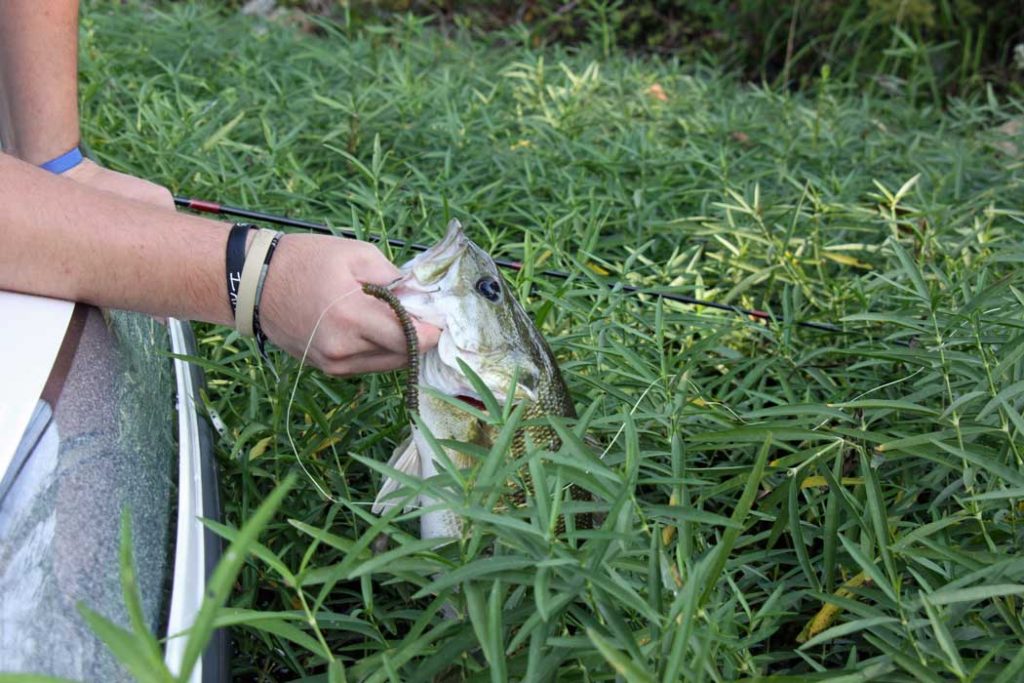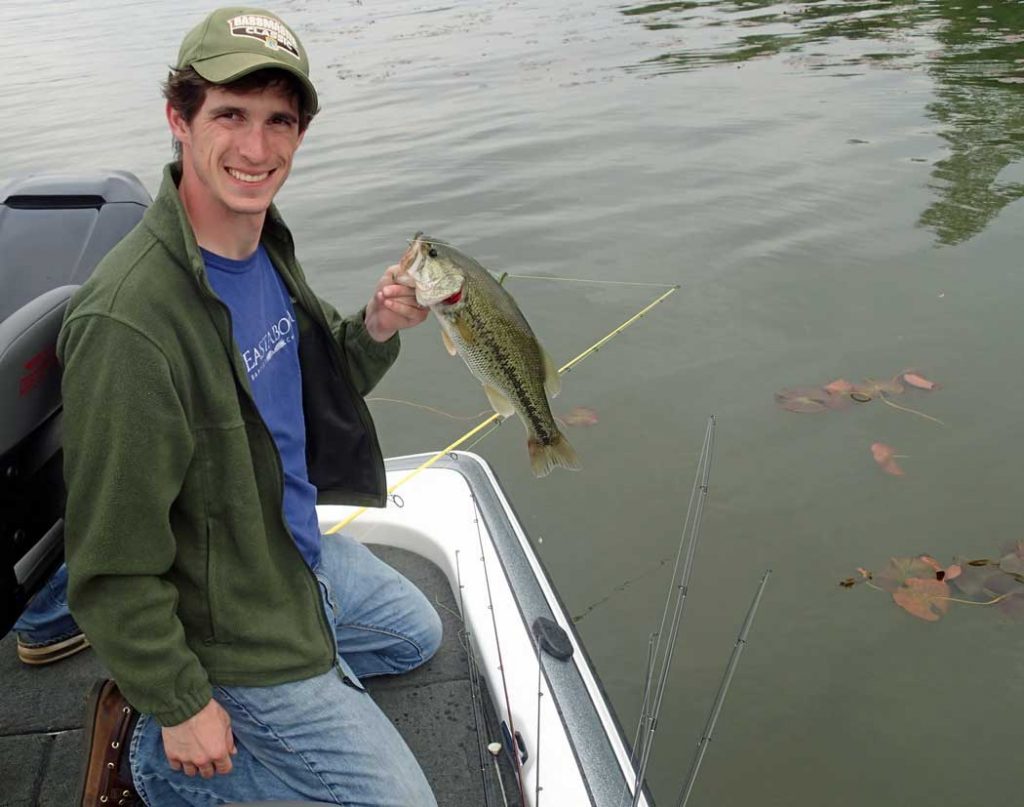Grass and weeds are prime locations for anglers to mow down bass in late spring.
One thing most lakes around the state have in common is weeds. By late spring, various weeds and grasses have sprung up around the shoreline. These grass and weed patches are perfect spots for bass to hide out in ambush for an easy meal.
Generally, anglers tend to clump all grasses and weeds into one name—weeds. However, there are some differences in the way these green salad bars grow. Bass anglers can approach most weed beds and grass mats with the same basic types of lures. But, there are some adjustments needed to go bass fishing in weeds.

Where to Start a Search for Weedy Bass
Some lakes have a more abundance of weeds, particularly shoreline weeds. As the water and the lake bottom warms up, weeds begin to grow. Shallow portions of coves and sloughs will usually have the first growth of weeds. As the days grow warmer, the weed patches will become thicker and grow farther out from shore.
In lakes where milfoil and hydrilla are common, growth can begin offshore on shallow humps and points. The weeds can be submergent, not yet reaching the surface. However, baitfish and bass will hold up in these offshore weeds as well as weeds along the bank.
“You look for two things when fishing grass,” mentions B.A.S.S. Elite pro Chris Lane of Guntersville, Ala. “You look for depth and you look for bait. Then you progress from there. Are the shad or bream in two feet or six feet of water?”
Baitfish will use the weeds as cover to hide from prey. Bass will utilize the weeds as an ambush point to snatch up any forage in the weeds. Shoreline weeds can also be home to frogs and snakes. These are also top food choices for a hungry bass.
“Throughout the summer, some bass will stay shallow in the grass and others will move out deeper.” — Chris Lane, B.A.S.S. Elite Pro
The weedline along the shore or submerged on a hump provides a break. A large patch of weeds can be like a big stump or rock to a hiding bass. The edge or break is one of the first sections of a weedline to begin your search for bass.
“Throughout the summer, some bass will stay shallow in the grass and others will move out deeper,” Lane says.
Later in the summer, the weeds will grow thicker and can form mats. The mats may be thick enough to create a canopy. The weed covering will provide shade and cover for bass. The canopy is not too thick to be penetrated by a lure.
Using Satellite Photos to Locate Weeds
Anglers can cash in on locating weedy areas around lakes by utilizing the technology of satellite photos. Google Earth can provide a birds-eye view of your lake and the extent of weed growth around it. Current and past photos can be viewed to determine how the weeds and grass have changed from past years.
“Weed growth can change from year to year,” advises Texas B.A.S.S. Elite pro Alton Jones. “The lake can be totally different from one year to the next in weed coverage.”
Jones uses Google Earth satellite photos and overlays them to see the variance in weed growth from years past. The photos are time stamped when the data was taken. Specific areas can be compared as to how much or how little the weed coverage has occurred.
In lakes that have extensive weed growth, the lake can be completely different from one season to the next. Also, weather conditions can have an effect on the weed growth. Extreme cold temperatures can kill off more grass than normal. It will take a little longer for these weeds to grow back.

Choosing the Best Lures for Weed Whacking
Certain lures are easier to fish in the weeds than others. Anglers will want to choose a lure that will hook up on the fish and less on the weeds. Some lures can cover the water more effectively and minimize having to free the hooks from weeds after every cast.
“I like where two different types of weeds come together,” Jones mentions. “I will first try a shallow-running crankbait along the edges of the weeds.”
Jones said the color is dependent on the type of forage present and water color. In clear water with a heavy presence of shad, a white or white / chartreuse lure should be the ticket. If the water is off-colored to stained, a lure with some orange or red would be a good choice.
Lane, too, agrees that a crankbait cast around the outer edges of the weeds will produce. He also suggests if the weeds butt up beside a channel or small stream to make a few casts along this area. Lipless crankbaits like the Rat-L-Trap or Red Eye Shad can be fished at different depths.
“Retrieve the lipless bait where it ticks the top of the submerged grass or weeds,” Lane explains. “If the lure hangs up, a quick twitch can rip the lure free and trigger a strike.”
Spinnerbaits are another top choice for weed whacking for bass. A double willow leaf blade style and be retrieved through the weeds. Anglers can hold the rod tip up for a shallower run and vary the speed of retrieve to reach the desired depth.
“Generally, dark colors seem to produce the best in late spring. Black, purple, or green pumpkin are excellent colors for whacking bass in the weeds.”
Large Colorado bladed spinner baits can be bulged just under the water’s surface in the midst of the weeds. The gurgling sounds and blade vibration will draw a strike.
Both Lane and Jones recommend a creature style soft-plastic bait rigged Texas style to punch through a heavy weed mat. A tungsten slip sinker in the 1- to 1 1/2- ounce size will provide enough weight to penetrate the weeds. The strike will be subtle and may be only a slight tick or a mushy feeling.
Generally, dark colors seem to produce the best in late spring. Black, purple, or green pumpkin are excellent colors for whacking bass in the weeds. Other soft-plastics like weightless worms, flukes, and swim baits are also good choices for weeding out bass.
For flipping gear, a heavy-action rod and 50- to 65-pound test braid is required to muscle the bass out of the weeds. Crankbait and spinner bait line in fluorocarbon around 14- to 20-pound test should suffice. Most types of weeds are abrasive and can easily wear or cut normal fishing string.
Anglers shouldn’t let a few weeds stand between them and a limit of bass. Pick up your gear, a few baits, and whack through some weeds for super bass action.



